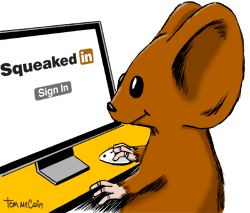 For those less electronically initiated, a webinar is an online virtual event that typically includes a small number of presenters delivering a slide presentation to a dispersed audience over the Internet. Participants view the webinar from their computer desktops and hear the audio through their speakers or over a telephone line.
For those less electronically initiated, a webinar is an online virtual event that typically includes a small number of presenters delivering a slide presentation to a dispersed audience over the Internet. Participants view the webinar from their computer desktops and hear the audio through their speakers or over a telephone line.
Using an outside webinar delivery platform makes sense for most companies. Many of these systems offer interactive capabilities such as:
- Live chat.
- Question and answer boxes.
- Audience polls and surveys.
- Virtual white boards.
- Desktop application sharing.
- And a number of other options.
They also generally offer customizable registration materials as well as tracking, automated reminders and post-production reports. Providers typically support popular programs such as Microsoft Word, Excel and PowerPoint. Some can provide event management services for an additional fee.
So How Much Do Webinar Services Cost?
Actual delivery costs vary, but most license agreements are fairly modest. For example, GoToWebinar, one of the more popular delivery systems, offers flat-fee pricing that allows you to conduct unlimited Webinars for one rate. You can purchase a standard, single-user license online for $99 per month or $948 per year. There are no additional licensing costs for attendees to join.
Are Webinars Better Than In-person Events?
They are two different animals, each with its own set of pluses and minuses. The big advantage of webinars, especially with strained budgets, is the low cost to reach an audience anywhere in the world. In many ways, the cost structure helps to level playing fields among small and large companies, just as digital communications do in many other marketing activities.
Webinars are also:
- Convenient and cost-effective for participants who don’t have to travel—distance becomes a non-factor.
- Convenient for presenters who can be at multiple locations and likewise avoid travel.
- Capable of bringing valuable information quickly to market.
- Efficient at speeding the sales cycle with proper follow up.
Some of the drawbacks include:
- More competition than for in-person seminar events.
- Less interaction with participants.
- Limited flexibility to change presentation order and flow.
- Restrictions on managing questions.
- Technology dependence to the ultimate degree.
In both types of events, you need to have a relatively large universe of qualified prospects. The general guideline for webinars is that approximately 5 percent of those invited will register and half of those will not attend. Some, however, will view the on-demand, archived version later.
Do Decision Makers Like Webinars?
Studies and my personal experience say they do. According to a white paper by Ridge Business Development LLC, The Benefits and Pitfalls of Webinars, people like the idea of learning about products and services without having to deal with a salesperson.
The white paper also points to a recent survey by Gartner indicating that 86 percent of respondents will view as many or more webinars this year as last. And a survey by PR Canada similarly indicates that only 7 percent found webinars a waste of time, while 86 percent fount them convenient and 66 percent found them time effective.
What If We’re Not Ready to Sponsor a Webinar Ourselves?
Many trade publications and associations offer webinar sponsorship opportunities that enable you to test the medium with varying degrees of participation. For example, you might strictly serve as the sponsor. But you also might be able to suggest topics, give input on selection of the featured presenter, provide qualifying and polling questions and perhaps even deliver part of the presentation if you choose.
You’ll typically get a banner ad at the registration site, inclusion in all of the promotional efforts and, of course, mentioned as the sponsor during the webinar. Additionally, you’ll virtually always get access to the registrant list for follow up.
This all comes at a price, of course, and $10,000 to $30,000 isn’t unusual. But a strong publication or association might also draw participants that you wouldn’t attract on your own, and it greatly reduces your time investment. Plus, it’s a good way to get started.
By Larry Bauer
Want Expert Advice?
MondoVox Creative Group can help you create content, develop professional webinar presentations and effectively promote the event in multiple media. For more information, email Julia Moran Martz.
You can connect with Julia Moran Martz on LinkedIn. Or follow her on Twitter.








